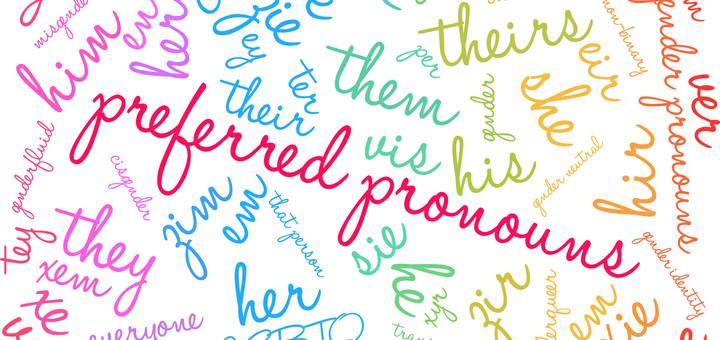A Primer on Pronouns: Using the Singular ‘They’
A MiddleWeb Blog
 It’s high school graduation weekend for my daughter: days full of elation, pride, relief, celebration, and the minefield known as modern pronouns.
It’s high school graduation weekend for my daughter: days full of elation, pride, relief, celebration, and the minefield known as modern pronouns.
My kid isn’t nonbinary, but she is friends with many young people who are. I’m a rank newbie at using pronouns respectfully, but I am trying really hard not to be.
These past few weeks in particular, when I am asking about young people’s plans, relating young people’s plans to other highly invested people, inviting young people over, and determining how many young people are actually coming over, I’ve been heard to say things like:
“Wait, do you mean all of them are attending Hartwick College?” or “When you say ‘they’ want pizza, are you talking about all your friends or just Ross?”
It’s not that I don’t believe gender and/or sexuality lies on a spectrum (I do), and it’s not that I find the effort to change my speaking patterns inherently irritating or annoying (I don’t). And it’s not because I am especially worried about over-ordering pizza, since that’s impossible with high school seniors.
It’s because I am an English teacher. Not only am I operating from brain-deep ingrained linguistic habits, but I have been teaching them to other people for over 20 years now. My trained writer friends experience similar challenges.
Perhaps, I wondered, is the MiddleWeb readership in a similar situation? We may be struggling to change our language so that all our kids are included, seeing an uptick of kids in the classroom who are comfortable with expressing their gender in nonbinary ways, or wondering which of our grammar lessons don’t really apply anymore.
Below, some quick tips, tricks and reading that have helped me a lot.
“I’m always surrounded by my bees.” This charming post about keeping pronouns straight also serves the invaluable purpose of giving us a perfect mnemonic for remembering to use the singular “they.” You’re not referring to a “he” or “she” – you’re also referring to their beautiful, powerful, personal bee swarm. This could also be a great way to teach the singular “they” should you have the opportunity to do so.
Just apologize. When you screw this up (and you will), correct yourself quickly and move on. Apologize briefly in private, if your realization that you screwed up occurs a while afterwards. Don’t belabor the point – it’s embarrassing for everyone that way.
You punched their arm. After your brief, heartfelt apology, most folks will grant you grace during your learning curve. Some have been victims of micro and macroaggressions for awhile, particular as adolescents, and they won’t. If that bothers you, read the linked quote from Ijeoma Oluwo, which I carry in my heart now always. It is actually our job to extend grace, not theirs.
How do I teach this? Really nice, succinct, K-12-oriented guide here from the Graduate School of Education at University of Pennsylvania. (Also addresses better ways of addressing a classroom than “you guys,” which is something I’m still training myself out of.)
But singular “they” is wrong. It’s not, actually. Send prescriptivists to this site.
What’s a pronoun again? Really? You just need to walk away from the ELA teacher now.
This is my last post of 2020-21. I am wishing you deep rejuvenation, peace, and rest this summer.





































Thank you!!! Good to know this struggle doesn’t belong just to me!
NOT AT ALL :) :)
What timing! I was just discussing this very topic with another teacher friend of mine. We need more PD on how to teach pronouns (or when not to). Thanks for sharing.
I agree! I don’t envy the PD experts or coaches for whom this may be a political minefield. That being said, our kids are the ones who are going to tell us what they need.